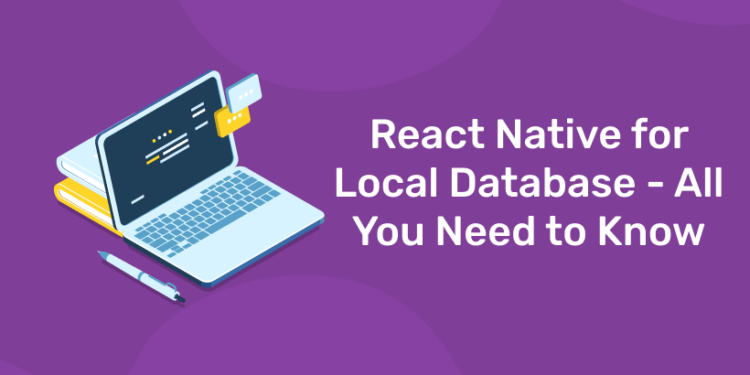Table of Contents
Key Takeaways:
- Choosing the right database powers your app’s performance, user satisfaction, and offline capabilities.
- 2025’s top databases include SQLite, Realm, WatermelonDB, RxDB, and PouchDB; each excels in specific use cases.
- Critical factors: data complexity, sync needs, security, and ongoing community maintenance.
- Emerging trends: Offline-first app design, real-time sync, and the growing importance of encryption.
- FAQs, tips, and up-to-date comparisons inside help future-proof your React Native projects.
Introduction: Why Local Databases Matter in 2025
Picture this: You’re tracking your daily steps, making shopping lists, or checking vital medical information—when suddenly the network drops. What happens to your data? In an era where every second counts and mobile users demand smooth, reliable experiences, the ability to function offline and rapidly sync data is no longer just a nice-to-have—it’s a competitive necessity.
For developers, “local database” isn’t a buzzword. It’s the backbone ensuring apps run efficiently, preserve data, and maintain user trust, even without constant connectivity. Choosing wisely today means fewer crashes, happier users, and apps that stand out in a crowded marketplace.
Learn more at Introduction to React Native
Major Factors to Consider When Picking a React Native Local Database
1: Which of the following is a JavaScript framework/library?
Data Complexity & Structure
-
Do you need simple key-value storage, or are you handling complex, relational data?
-
If your app manages nested or related data (think multi-user chat, inventory systems), opt for databases like Realm, WatermelonDB, or SQLite that manage relationships and queries gracefully.
Offline Synchronization
-
For users in travel, remote regions, or unreliable network environments, offline-first support is essential.
-
Realm, Firebase, PouchDB, and WatermelonDB are leaders in built-in sync and offline data management, allowing seamless user experience and robust background syncing.
Meaning: Offline-first means data is always available, with changes auto-synced once connectivity resumes.
Performance & Scalability
-
If you expect thousands of records or high-transaction volumes—such as social media feeds or analytics—look for options with multi-threading, memory efficiency, and concurrency controls.
-
WatermelonDB and MMKV are praised for their high performance and ability to handle large data sets on mobile.
Security & Encryption
-
With growing data privacy concerns, choose databases supporting robust encryption for sensitive data.
-
Realm and certain configurations of SQLite offer at-rest encryption, and PouchDB can be enhanced with plugins.
Migration, Maintenance, and Community Support
-
Always verify whether a library is actively maintained. Deprecated libraries can introduce security risks and bugs over time.
-
Migration pathways (transferring from one database to another) and developer tooling determine longevity and adaptability.
Tip: Regularly check official GitHub/NPM repositories for update frequency and GitHub issues to judge real-world support.
🚀 Start Coding Today! Enroll Now with Easy EMI Options. 💳✨
Get Hired as a Full-Stack Developer: Master the Skills Employers Are Looking For!
Start Learning With EMI Payment Options2025’s Trending Local Database Options for React Native
SQLite
-
What it is: Lightweight, serverless SQL database, a classic for structured data storage.
-
Strengths: Extremely reliable, widely documented, high compatibility. ACID-compliant (Atomicity, Consistency, Isolation, Durability).
-
Weaknesses: No built-in sync, manual migrations can be challenging, complex relationships require extra work.
-
Best for: Finance, healthcare, inventory, and apps needing transactional integrity.
-
Useful Stat: Used in 70% of enterprise mobile apps due to its proven reliability.
Realm (MongoDB Realm)
-
What it is: Advanced NoSQL object database (now MongoDB Realm) with built-in real-time sync, strong encryption, and developer-centric APIs.
-
Strengths: Real-time sync, schema flexibility, easy integration, multi-language support. Handles large/complex data structures efficiently.
-
Weaknesses: Proprietary sync/cloud options introduce vendor lock-in/costs; open source for fundamental features.
-
Best for: Real-time collaboration, health apps, fintech, social platforms.
-
Pricing: Open source for local use; premium plans start for advanced sync/cloud.
-
Stat: Realm’s mobile database usage grew 18% year-on-year from 2024-2025.
WatermelonDB
-
What it is: High-performance database designed for React Native, handles immense volumes (100,000+ records), built for offline-first and multi-threaded processing.
-
Strengths: Excellent for performance on low-end devices, supports direct sync code, offline-first.
-
Weaknesses: Setup and API require learning; not ideal for simple apps.
-
Best for: Large-scale productivity, CRM, analytics, and fieldwork apps.
-
Tip: Supports sync with backend via custom adapters for advanced apps.
Firebase Realtime Database / Firestore
-
What it is: Cloud-hosted, NoSQL by Google with cross-device real-time updates and offline persistence.
-
Strengths: Effortless real-time sync, robust collaborative features, generous free tier.
-
Weaknesses: Dependent on internet for multi-device sync, potential for rising operational costs.
-
Best for: Messaging, social, gaming, collaborative productivity, and live dashboards.
-
Stat: 1.5M+ apps used Firebase/Firestore for mobile development in 2025 (per Google).
RxDB
-
What it is: Modern, reactive NoSQL database for real-time UI built on RxJS, syncs with CouchDB.
-
Strengths: Live queries, built for observability, cloud sync, advanced RxJS support.
-
Weaknesses: Relatively newer in the RN ecosystem; requires understanding reactive programming.
-
Best for: Real-time dashboards, IoT, collaborative/instant update apps.
PouchDB
-
What it is: JavaScript open-source database syncing smoothly with CouchDB, uses JSON for storage.
-
Strengths: Seamless offline-first and cloud sync, highly flexible, great for distributed field apps.
-
Weaknesses: Optimization needed for very large data sets; plugin-based encryption.
-
Best for: Logistics, eCommerce, distributed workforce apps.
-
Tip: PouchDB-authentication plugin available for data security.
MMKV (WeChat)
-
What it is: Key-value storage developed by WeChat, lightning-fast for preferences/temporary state.
-
Strengths: Superb speed, small app footprint, perfect for settings or caching.
-
Weaknesses: Not ideal for large or relational data.
-
Best for: Storing app/session settings, high-frequency data.
Tip: Combine lightweight storage (AsyncStorage or MMKV) for preferences with a full-featured database for user data.
2025 Comparison Table: Top React Native Local Databases
| Database | Type | Cloud Sync | Real-Time | Encryption | Best For | Concurrency | Web Support | Community Support | Free Tier |
|---|---|---|---|---|---|---|---|---|---|
| SQLite | SQL | No | No | Yes | Structured/Relational | Yes | Limited | High | Yes |
| Realm | NoSQL | Yes (Paid) | Yes | Yes | Real-Time/Complex Data | Yes | Limited | High | Yes (basic) |
| WatermelonDB | SQL/Hybrid | Custom | Yes | Yes | Large Data Sets/Offline-first | Yes | Yes | Growing | Yes |
| Firebase | NoSQL | Yes | Yes | Yes | Social/Collab/Realtime | Yes | Yes | Very High | Yes |
| RxDB | NoSQL | Yes (Couch) | Yes | Yes | Live UI/Reactive Programming | Yes | Yes | Growing | Yes |
| PouchDB | NoSQL | Yes (Couch) | Some | Plugin | Distributed/Field Data | Yes | Yes | High | Yes |
| MMKV | Key-Value | No | No | Yes | Preferences, Fast Caching | Yes | Yes | Moderate | Yes |
-
Tip: Always test database performance on both high-end and low-end devices before launch—real-world use may expose bottlenecks.
-
Tip: Encrypt user data to sustain regulatory compliance and user trust—never compromise on security.
-
Tip: Keep all libraries and plugins up-to-date; old code is the biggest cause of app vulnerabilities and crashes.
-
Tip: Use feature flags in your dev process to experiment with multiple database backends for the best fit.
-
Tip: Monitor and optimize sync/fetch logic for battery life on mobile devices—efficient local storage means happier users.
Why Choosing the Right Database Matters for Modern React Native Apps
-
Fact: Local database integration directly impacts app store ratings, user retention, and ongoing engagement—especially in emerging markets where connectivity gaps are common.
-
The right choice in 2025 means easier scaling (as user bases grow), reliable offline workflows, fewer crashes, and quicker releases.
-
Trend: The global React Native developer ecosystem is expanding, with local-first architectures now considered a foundational skill for app careers.
🚀 Start Coding Today! Enroll Now with Easy EMI Options. 💳✨
Get Hired as a Full-Stack Developer: Master the Skills Employers Are Looking For!
Start Learning With EMI Payment OptionsEntri’s AI-Powered Full Stack Developer Course: Fast-Track Your Career
Eager to master these in-demand tech skills and transform your career? Entri brings you an industry-leading AI-powered Full Stack Developer Course tailor-made for aspiring developers and IT professionals.
Why Entri?
-
Learn React Native, database integration—including SQLite, Realm, Firebase, and more.
-
Real, project-based learning with hands-on challenges.
-
Job-focused modules and live industry projects for immediate employability.
-
Placement assistance and industry mentorship to land your first job or upskill with confidence.
-
AI-driven personalization to help you build skills faster, with guidance every step.
-
Vibrant developer community for networking, peer learning, and lifelong growth.
Start building apps that stand out. Future-proof your career with Entri’s blend of tech, mentorship, and placement support. Enroll here
Conclusion
In a world where user attention spans are shrinking and app competition is intensifying, the database powering your React Native project is as crucial as your code. Today’s fastest-growing apps succeed by delivering smooth, offline-first experiences, secure data handling, and real-time sync—regardless of where users are. Smart database choices set you—and your app—on the path to user love and business growth.
Ready to level up? Master these skills with Entri’s Full Stack Developer Course—where learning meets placement, mentorship, and a launchpad into tomorrow’s best tech roles.
|
Related Articles |
|||||
| The Best IDEs for React Native | React Native Chart Libraries- Details and Examples | ||||
🚀 Start Coding Today! Enroll Now with Easy EMI Options. 💳✨
Get Hired as a Full-Stack Developer: Master the Skills Employers Are Looking For!
Start Learning With EMI Payment OptionsFrequently Asked Questions
What’s the fastest offline database for React Native?
WatermelonDB and MMKV are recognized for their lightning speed, especially with massive or high-frequency data.
Should I use Realm or SQLite?
Realm is best for real-time, complex data, and sync; SQLite excels in structured, transactional apps and legacy system integrations.
Are Cloud sync and offline support the same?
No. Offline means your data is available and editable without the internet; cloud sync means changes appear across devices once you’re online.
How can I migrate data between databases?
Always export/import data using industry standards (JSON/CSV), and leverage migration tools provided by the library or community plugins.
Can I implement multiple databases in one app?
Yes, combining MMKV/AsyncStorage for preferences with Realm/SQLite for main data is increasingly common.
What about data security?
Choose a database with at-rest encryption and keep libraries updated for current security patches.














